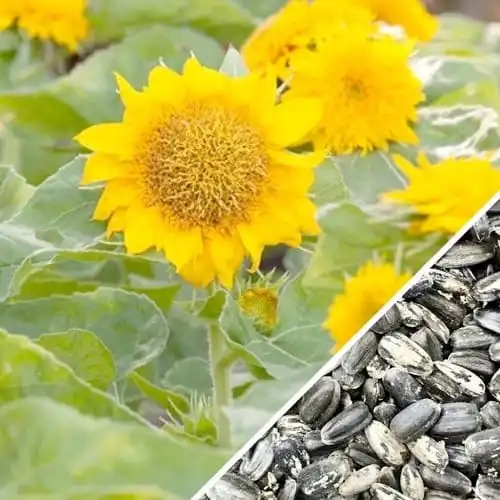Did you know that despite being typically associated with the outdoors where they can reach several meters in height, some people have considered growing sunflowers indoors?
Can you grow a sunflower indoors? Sunflowers can be grown indoors at any time of year if they are provided with the right environment. Proper placement centers around the flowers receiving generous amounts of light (6-8 hours per day) from the sun or from grow lights. Sunflowers require watering approximately once per week.
Let’s take an in-depth look at everything that you need to know about growing sunflowers indoors!
How To Grow a Sunflower Indoors
Believe it or not, sunflowers can indeed grow indoors. Below, we cover each aspect of growing and caring for sunflowers indoors.
1. Choose a Variety
There are several types of sunflowers that work well indoors (see section on best varieties below), so the choice is really up to you and your personal taste.
Be sure to take into consideration the differences between the varieties, such as size, watering and lighting needs, bloom time, and more.
‘Strawberry Blonde’, ‘Moulin Rouge’, and ‘Taiyo’ are a few of the most popular sunflower varieties to grow. Make sure to research any variety you are interested in before picking one.
2. Select the Best Container
Depending on the variety of sunflower that you choose to grow, the best container differs.
Smaller varieties may be grown in 1- or 2-gallon containers, while the largest species should be planted in 5-gallon containers. Ideally, larger containers should be 12-18 inches deep.
The best shape for the container depends on where you plan to place your sunflowers and how it fits into your home environment.
3. Carefully Sow Seeds
Sowing seeds properly is a crucial step in growing sunflowers. Seeds should be poked into the soil approximately 1 inch deep.
Be sure to use well-draining soil, and keep it extra moist while waiting for seeds to germinate. Water the seeds a bit each day.
Outdoors, sunflowers are normally planted around 12 inches apart. Inside, depending on how you plan on arranging yours, you may want to consider planting them closer to each other.
Otherwise, you’ll end up with no more than one or two flowers per pot.
4. Proper Watering
After they’ve germinated and begun growing, sunflowers only need watering every 5 to 10 days.
The amount of sun, temperature, and soil makeup are significant factors that help determine how often watering is required. Try to keep the top 4 to 6 inches of soil moist.
5. Light Fertilizing
Fertilizer for sunflowers is available at almost any garden center or big box store; you can also find it online.
Depending on the product, you may add it to the water for every watering. That said, some products only need to be applied one or two times per year.
Personally, I recommend this organic fertilizer as it’s not only safe to use around humans, but it’s also safe to use if you have any pets in the home.
It encourages gorgeous, large blooms, and adds critical mycorrhizal fungi (I explain what this is here) to the soil as well.
6. Careful Plant Placement
Once you have fledgling sunflowers, move them from wherever they’ve been germinating and sprouting and place them in their new “forever home.”
The best place for sunflowers is in west- or south-facing windows where they will receive several hours of sunlight each day.
Sunflowers need at least 6 hours of light each day but do better with 8 or more.
7. Consider Grow Lights
If your sunflowers aren’t able to soak up sunlight from west- or south-facing windows, consider adding a grow light or two somewhere around.
Lights may be clamped to the side of the plant, hung from the ceiling, or mounted on the wall.
Grow lights for houseplants may be picked up from just about any gardening center, but I recommend this one from Amazon as it hangs from the ceiling and can be adjusted as your sunflower gains height.
Best Sunflower Varieties To Grow Indoors
There are over 70 common species of sunflowers with countless varieties. Most of them may be grown inside.
These six sunflower varieties are among the most popular to grow indoors:
- ‘Little Becka’
- ‘Strawberry Blonde’
- ‘Moulin Rouge’
- ‘Italian White’
- ‘Soraya’
- ‘Taiyo’
- Shop sunflower seeds and growing kits.
- Order online, fast shipping!
Sunflower Care Tips

Taking care of indoor sunflowers is a bit different than caring for sunflowers grown outdoors. The tips below will help you get it right the first time around.
Sun
If you want the best results, your sunflowers need lots of sunlight (go figure, right? As if the name didn’t give that little tidbit away!).
Eight to 10 hours is suggested, though it will survive with much less. If your sunflowers receive less than 8 hours of sunlight, consider giving them some light from grow lights in addition.
Water
Use a moisture meter to track how wet your sunflower’s soil is. Make sure to keep the top several inches moist at all times (not soaking, just moist).
Old-timers recommend adding a teaspoon of sugar and a splash of bleach to the water every now and then to keep your sunflowers looking their best.
Support
The use of stakes or a trellis system of some sort is highly suggested for the best indoor sunflowers. If you have ever grown sunflowers before, you’ll know that they get top-heavy once their heads begin to grow.
Stakes and string or a trellis takes care of this issue and adds a bit of charm to the mix as well.
Fertilization
Using a slow-release general-purpose flower fertilizer and organic compost (learn how to make your own here) for your sunflower is the best approach for healthy and great-looking plants.
That way, they get the right sort of nutrients over a longer period of time with little to no extra effort on your part.
Sunflower Diseases To Watch For
Sunflowers are a hardy plant that is much sturdier than the common flower. In fact, compared to common flowers, sunflowers might as well be trees.
At any rate, they are affected by diseases just like any other plant. A few of the most common sunflower diseases to look out for include:
- Alternaria
- Charcoal rot
- Downy mildew
- Phomopsis stem canker
- Rust
- Rhizopus head rot
- Sclerotinia wilt
- White mold
- Verticillium wilt
Related Questions:
How Long Do Sunflowers Take To Grow?
Sunflowers take anywhere from just under three months (80 days) to around four months (120 days) to reach maturity.
That said, there are many varieties of sunflowers and all of them grow at slightly different paces.
How Late Can You Plant Sunflowers?
Inside, you can plant sunflowers any time of the year (with a bit of care). Outside, most folks get their planting done between March and May.
However, sunflowers may be planted nearly until the end of the summer and still grow and bloom (they will just be shorter than usual).
A Final Word About Growing Sunflowers Indoors
Growing sunflowers indoors is different than caring for most houseplants, but it can indeed be done and is a great gardening practice for those who love sunflowers and want to have some around all year long.
With just a little know-how and the tips found above, you’ll soon be a sunflower pro and the envy of your friends!


